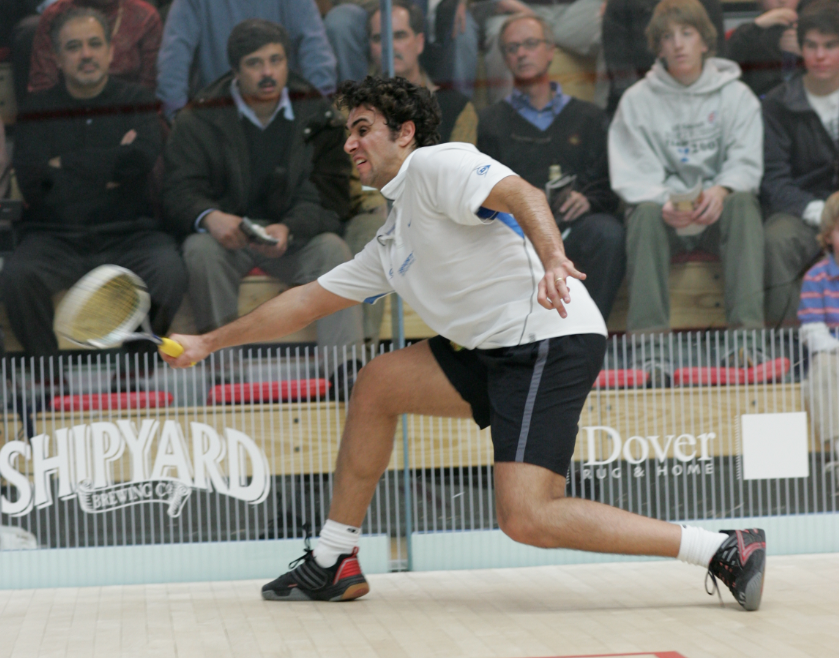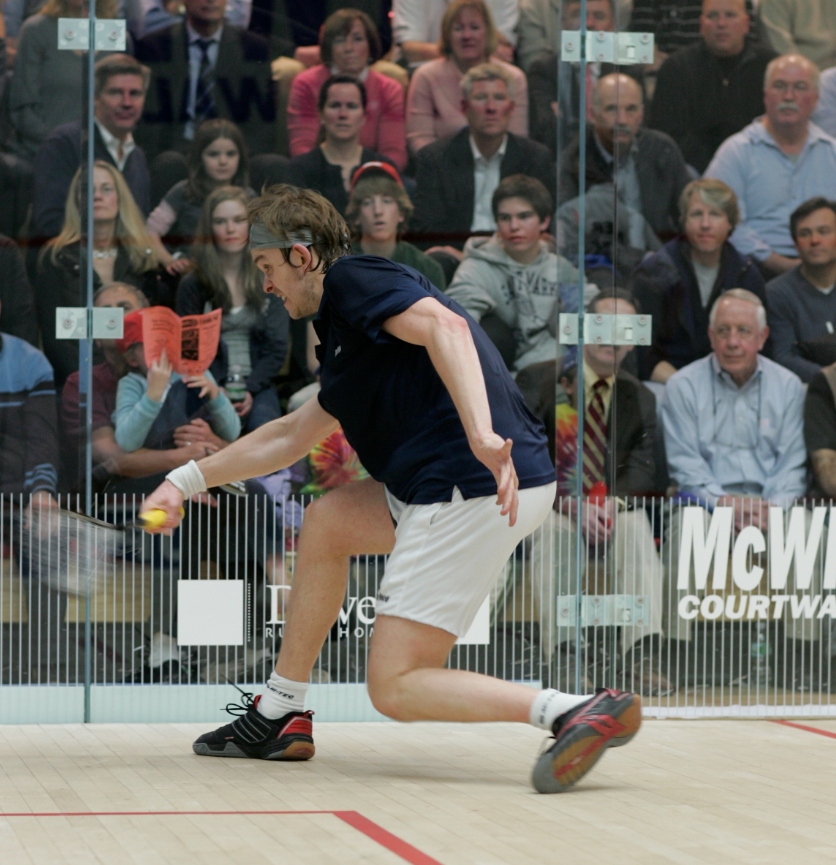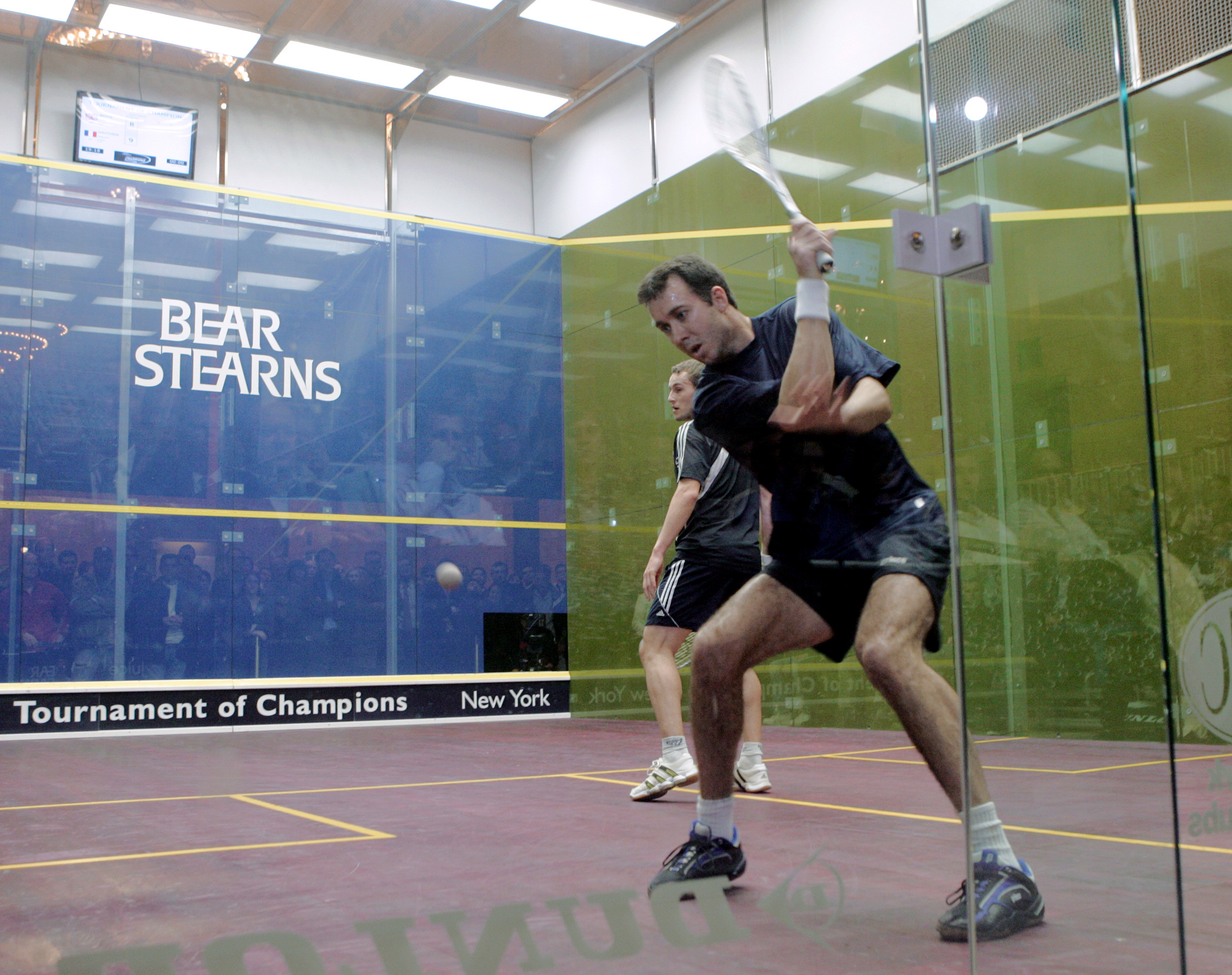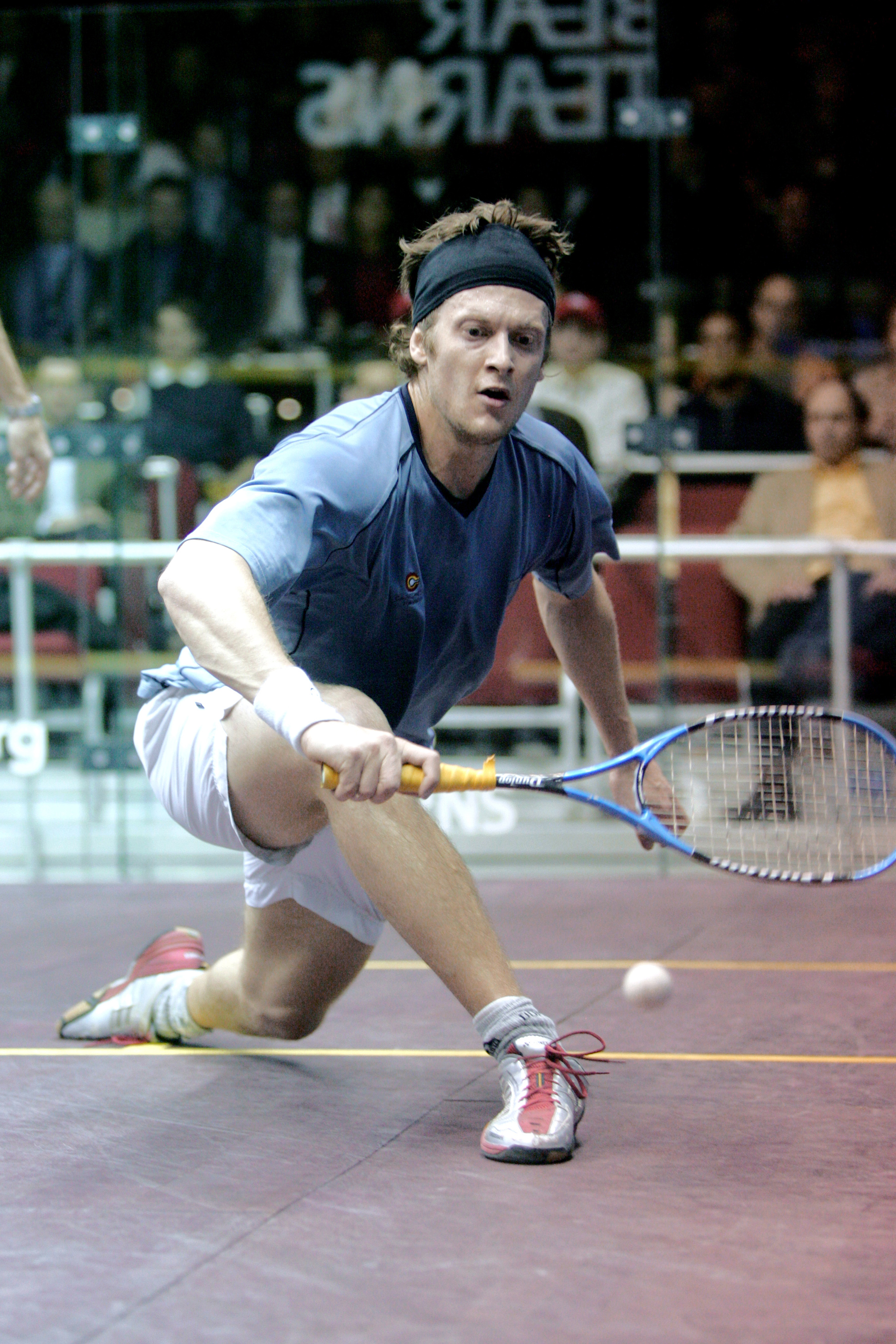By Richard Millman, Director of Squash, Kiawah Island Club

Have you found yourself languishing at the back of the court, gazing at the less than inspiring sight of your opponent’s bony shoulder blades poking insultingly back at you? If so, you are suffering from a very common problem that faces most squash players at some point in their squash careers.
Why does it happen to you? Well, there are at least a couple of reasons.
First, most people become conditioned to the comfort and satisfying feedback of a sweetly struck, full swing stroke. How does this occur? Well…generally when you learn the game, your friendly neighborhood squash coach teaches you a basic swing with a full preparation and a full follow-through. This is usually played from a delicious dolly drop of a feed, which hangs in the air for what seems like an eternity, just waiting for you to smack it triumphantly to the back of the court. This is as it should be—the coach should give the learning player maximal time to execute the new technique. Unfortunately, all too often, this basic stroke becomes, whether by inference or implication the ‘correct way’ to hit the ball , rather than the ‘basic way’ to hit the ball. Frequently this is the only stroke/swing technique that a player learns and the important explanation that this stroke is simply the beginning of a series of progressions in the development of swing technique that the player should be carefully guided through, is never offered. The key explanation that the amount/volume of swing mechanics that should be employed must be proportional to the amount of time that the striker either has available or wishes to use, is an essential part of this advice.
Squash players, by and large, are bright people, and if you ask the average player whether a volley swing is smaller than a full ground stroke swing, then of course they will tell you that it is.
If, on the other hand, you feed them a high serve to the backhand side wall, that preconditioning that has made them so comfortable with a full stroke, will see them backing off farther and farther—trying to find time and space to execute that oh so satisfying swing that gives them the delicious feedback of a well-whacked ball. Of course, that time and space never arrives as the ball drops down on them from the ethereal height of the rafters, glances off the side wall at the angle of a medieval arrow that is threatening to transfix you through the heart and, in what seems the blink of an eye, it drops with a delicate—though sickening—thud on the floor in the back corner. This action may or may not have been accompanied by a loud swoosh from your manically slashing racquet, as you attempt to defy time and physics and fit a swing that takes at least a fifth of a second into the period of time that the ball is momentarily available, which sadly only takes one tenth of a second.
Hence the phenomenon of the player stuck in the back of the court because they can’t ever seem to find enough of an opportunity for the early stroke they are so desirous of attempting.

The second reason, that players get stuck in the ‘gaol’ of the back of the corners, is a failure to get the sequence between moving into position for the next shot and striking the current shot in the correct order. For years there has been a worldwide misunderstanding in the sport about this simple sequence of events. Let’s clear that up here and now, once and forever. When playing a squash shot you should organize and begin your movement into position for your next shot BEFORE you hit the ball. Do not hit the ball and then think about moving into position for the next shot.
Please, if you are a coach or mentor, never you use the advice ‘after you hit the ball, get back to the ‘T’.’
This misleading direction causes a whole slew of misguided, misdirected behavior that some players never recover from. In the case of getting stuck at the back of the court, this is the how it creates the problem:
1: The player in the back court strikes the ball—immediately making it available to the opponent.
2: The opponent begins moving to play the ball.
3: The striker attempts to ‘get back to the T,’ becoming absorbed by an over-riding desire to gain the mystical possession of the red painted intersecting lines, while—even if only momentarily—losing connection with their lifeline to the game: The ball.
4: While the striker is rushing headlong toward the ‘T’ and safe ‘home,’ the opponent intercepts the ball, striking it in the diametrically opposite direction to that which the original striker is now, kami kaze-like, throwing their entire mass.
5: In a desperate and all too late attempt at rescue, the original striker tries to wrench their body weight away from the ‘God’ of the ‘T,’ to reconnect with the ball (their erstwhile interest) and they find themselves wildly lunging to the back of the court, once again playing catch up, whereupon the whole sad sequence repeats.
What’s the alternative?

This is the alternative:
1: On arriving in position to play the ball, the potential striker gauges how much time they will need to get into position to be ready for the the opponent’s next possible choice of shots.
2: Having assessed how much time they need, the striker starts moving into position, marginally before striking the ball.
3: As the striker is moving to position for the next shot, while maintaining primary physical, mental and emotional focus on the ball (and a secondary level of attention on their physical position in the court), they maintain an ever ready, prepared response in order to be able to instantaneously react, should the opponent redirect the ball earlier than expected.
4: Having designed their shot to allow sufficient time to position for the opponent’s next shot, and never having had their primary focus diverted from the ball by that wicked old fairy tale about the so called ‘T’, the original striker is balanced, poised and ready to pounce when the opponent intercepts the ball, and is able to intercept the ball early to take a position in the front of the court and at least temporary command of the rally.
So having identified these two major causes of the back court trap, what to do to cure the problem?
For a beginning, learning to adapt swing size to time, is a must for anyone who wishes to be competitive and get forward in the court. Obviously some dedicated time with your chosen professional is a good place to start with this. However, if you don’t have immediate access, or even if you have begun to spend some useful time improving your ability to shorten your swing, here are some great drills to help you on the way:
1: The Volley Game You and your partner stand on opposite sides of the court, both of you in the back quarters. The objective of the game is to land the ball on the floor on your opponent’s side. It must hit the floor over the short line and before the back wall to be considered good. To prevent the opponent from winning the point, you must cut it off on the volley. Play up to 15 points, American scoring on one side and then switch and play another game on the other side.

2: The No Back wall Length Game You and your partner play every ball to the back of the court (over the short line). However, if either one of you manage to get the ball past the opponent to the back wall, that person wins the point outright (the ball must bounce before it hits the back wall to be good). Play up to 15 points, American scoring.
3: The No Back wall Volley Length Game Same as above except you have to stop the ball from bouncing at all in the back court. This is a tough game and shouldn’t be attempted unless you’re pretty hot at Game number 2.
4: The No Back of the court game This is one fast game—so you had better have perfected your short swing and movement planning skills. Draw an imaginary line across the court from the back of each service box. Everything behind that line is out of bounds. Then play a regular game of squash except the ball must always bounce somewhere in front of that imaginary line. If the first bounce lands over the back of the service box line, it’s out. Also you are only allowed to put one foot behind the service box line to retrieve the ball. Two feet out is a fault and you lose the point. The serve only has to go above the service line and onto your opponent’s side—it doesn’t have to go over the short line. Play 15 points American.
5: The Short No Back of the court game Same as number four, except now the back of the court moves up from the back of the service boxes to the short line. You better be quick and don’t leave the opponent short too early or the ball will be gone! 15 Points American again.
There are more games than these, but if you can practice these five, while maintaining balance and the quality of your technique, you will find it far easier to gain the dominant, front position in the rally.
Make no mistake: An early volley—even a gentle one (as long as it is accurate)—is always better than a hard full swing ground stroke and is your ticket to get up the court.
So cheers and here’s your ‘Get out of gaol free’ card. Use it and get in front!
Skill Level Tips
Simple practice tips for 3.0, 4.0 and 5.0 players
3.0 To improve your short swing skills, stand in the middle of the court about 8 or 9 feet back from the front wall and alternately hit a gentle forehand and a gentle backhand, back and forth to yourself. Keep it slow and decrease your normal swing to less than half it’s original size, still maintaining balance and footwork.
4.0 In the same vein as the 3.0 drill above, stand about 8 or 9 feet back from the front wall. This time however instead of letting the ball bounce, do the drill by volleying the ball. Remember you have even less time now, so decrease the swing size even more and, while still keeping good balance, decrease the amount of foot work technique you are using.
5.0 You’re approaching a crucial game in the match and you really want to impose yourself. It’s a hard game and you’re pretty even with your opponent. Make a bold decision. Determine to step a yard further up the court than you have so far in the match and position yourself there consistently for the rest of the match, using a shortened swing to take the ball early and to steal and maintain the initiative.
Kiawah Island Happenings
The past two weeks have seen some exciting out of town successes for Kiawah Island and Charleston Squash club players, On the weekend of February 15th-February 17th, professionals Richard and Pat Millman visited the University Club in Washington DC to play in the Woodruff–Nee open skill level tournament. In the highest men’s division Richard Millman beat New Yorker Yahaya Nauzo, three games to nil in the final to take the title. In the top women’s division Pat Millman defeated local Washington player Annesley to take the championship. In the more than 50 year history of the tournament, this was the first time that a husband and wife had simultaneously competed in and won the event.
This past weekend The Charleston Squash club junior team and assistant professional Joe Millman both traveled to compete out of state. Playing in the $80k Virginia Open, Joe Millman (currently ranked 241 in the world professional rankings) met current world number 95 and Dartmouth alum Ryan Donegan.
Donegan proved too much of a mountain to climb on this occasion, beating Millman by a 3 games to 0 margin,
Meanwhile Coach Richard Millman and the Charleston Junior team traveled even farther to Baltimore Maryland to compete in the Meadow Mill Athletic club Bronze Junior championship. The 16 court athletic club provided a magnificent backdrop for the South Carolina team’s most successful venture yet,
Playing in only his second event out of state, 13-year-old Kevin Qualey lost in the main draw but then advanced to the finals of one of the consolation events, before losing a closely contested game.
In the girls under 19 event, Lily Greenberg recorded her best performance to date and took third place in the division. In the boys under 17 event Brendan Keane recorded his first ever first round win in the main draw. After losing to the number 2 seed he met and beat his brother Richard Keane in the consolation event and then went on to take fourth in the consolation,
Despite the loss to his sibling, Richard Keane played in the Plate event, and after winning the semifinal match 3-0, he played an epic match in the final to win the Plate event 3 games to 2, 10-9 in the fifth game.
Top honors of the weekend however went to 14-year-old Reynolds Ball. Reynolds won the Under 15 championship and, in doing so, recorded his first ever out of state tournament victory. Reynolds played with verve and maturity in the final. Having fallen behind and lost the first game to a formidable opponent, Reynolds came out in the second with and applied a detailed game plan—frustrating his agile opponent with a variety of accurate and wrong footing shots. He won the game 9-5. At one game all the match was evenly balanced and it was at this point that Reynolds demonstrated how far he has come as a squash player. Applying the game plan even more clinically, Reynolds took both the third and the fourth games without the loss of a single point—and thus became the champion.





